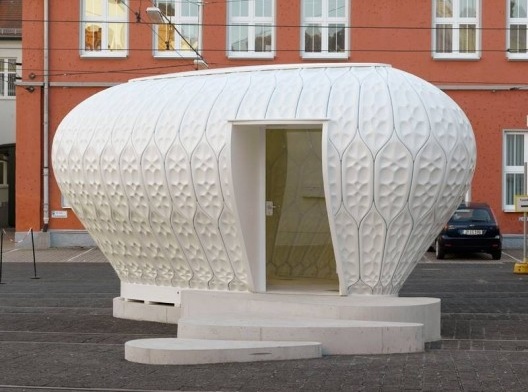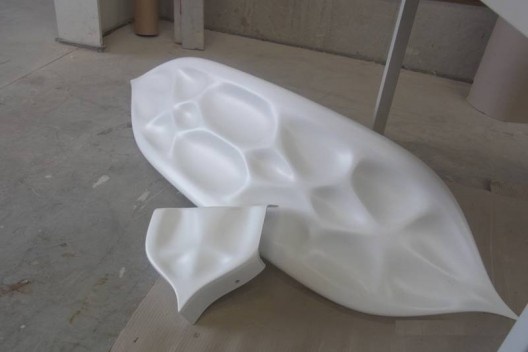
CocconPavilion [Foto divulgação]
GC: What type of work you do at programming for architecture, and does it compare to the work of other consultants, such as designtoproduction, designtofabrication, One to One or Imagine Computation?
MD: I don't know exactly what they do, but in general terms what we do should be the same. We have the same type of office. What I think that is different between me and most of them is that they largely cooperate with architects, while I cooperate with structural engineers and with building companies, like Seele (5). Some of them do cooperate with building companies, but I mostly cooperate with structural engineers, because in my PhD I developed this niche of static analysis. I can run algorithms that quickly generate the structures. With the algorithms I can do static optimization. I don't think any of them can do it, and this is why I'm getting a lot of work from structural engineers.
GC: What about the design of the structures? Designtoproduction, for example, does not design the building themselves. They get the concept from the architects and they do the parametric model or further develop the details algorithmically. What is the relation between your work and the architects' work in terms of the design?
MD: The problem is that I'm young and I'm not German. I don't have any connections here. People like Arnold Walz (from designtoproduction) have been around for a long time and they have lots of connections and friendships and so on. So, if I offer some service to an architect, but he does not know me, we are not friends, we don't have any connection, they will never give me the job. This is for a simple reason: in the design phase you are not limited or constrained by anything. There is no deadline, there is not precision about what you want to do. When I work to companies like Seele, there is no room for playing. They tell me exactly what they want me to generate; they give me the rules and I give them the precise elements, with screw and bolts, etc. However, in the design phase there is room for playing. So, an architect can come to me and ask: what can you do. And I'll say we can do this, and that, and that. And he sees it and if he does not want to pay me he simplifies the problem in such a way that an intern who knows some Grasshopper can do it, because in the design phase it is possible to do it in a simplified way. And I feel that's why I don't get work in architecture, and I feel that's why others get this type of work, because of their good connections, so architects will ask them to do it. Maybe they could do it with their interns but they have known each other for twenty years, so they say "I'll let you do it".
GC: That brings us to another very interesting topic in Architecture, which is the need for incorporating structural performance at the very beginning of the design process, which usually does not happen because the architect does not have the expertise and they don't want to pay for someone who has it. So, what would be the ideal world in terms of the relationship between structural design and conceptual architecture?
MD: This is exactly the biggest problem, as I said one million times in my life: architects want to save money at the beginning, so that is why they will not hire someone who programs. If you start working in the project at the very beginning and you start developing some algorithm along the way, then when the conceptual design phase is over, you have everything parameterized, you already have your algorithm, so from them on you can automate the whole process. But the problem is that architects are not concerned with what happens afterwards, usually, and they try to save money in their part of the process. So, only if you work for a company that does everything, from the conceptual design to the construction, they can understand the value of automating. But architects show no interest in that, although I've been trying to show them (the advantages of having a programmer from the very beginning). In a budget for a project there is no budget for programming. There is architectural design, there is static analysis, there is building, but not programming. And then people like us come into the play and one of the people in the chain has to pay us, and they fight between each other about who is going to do it. I recently had a project with that problem. The architects said they were going to deliver some free form roof structure to the structural engineers, so they could analyze it. But the structure was very complex, so it had to be programmed. And the question was who was going to pay for it: the architects or the engineers. At the end the structural engineers were the ones who paid me for the automation, but I think it was not fair. Architects should deliver a solved structure, but this seldom happens.
When I was in Brazil, after talking to Caroline Bos (a partner of UN Studio who was also a keynote speaker at CAAD Futures) I realized that there are these large architectural offices that do the design, then there are these big construction companies like Seele that build them. Between them there is no competition or overlapping of tasks. So they want to get me, of my type of consulting outside of the game. The goal of the large architecture offices or the large construction companies is to do what I do inside the offices, so they do not need to outsource. So, I can only get work if I can do something that no one in their offices can. That's the only way I can get work. Seele is in 15 countries and has a thousand employees, and only when no one can do something they will come to me. And many times they ask me to tell them what I can do, and then they say this is simple enough so we can do it ourselves. They only hire me if there is something extremely complex, which even I don't know if I can do it, but I usually say I can. Then I stress myself and find a way, and that's good for me because I learn out of that and I progress. It's very stressful, but it's the only way you can get work. So what we do is very instable in today's market.
GC: Can you tell me about the projects in which you are working right now?
MD: I'm currently working on the Bloomberg building in London, by Foster, and Seele is doing the construction. I'm doing the balustrade programming and it's going to last for 2 or 3 months. And the Schüco parametric façade system is still going on because we are doing some additional static analyses. Now I'm incorporating some little silicon members and I'm calculating the forces on them. And this has been for almost one year. I'm also working on a pavillion with Göran Pohl from Pohl architects. It's a project that was developed at the University of Saarbrücken and is being produced by Fiber-Tech (6). It looks like a project that Pohl did before, the Cocoon.
GC: And do you work on your own?
MD: In this work that I'm doing in London I didn't know it was going to be so much intense. I didn't have any experience working with such a big company so I miscalculated the amount of work. Now my sister is helping me, but she lives in Serbia. I would like her to come to Germany but I still cannot pay her enough to come. Somebody told me if I work in such an instable area I should calculate how much I need and then make it times five. But what I'm doing now is I'm calculating how much I need and dividing it by two, because it's very difficult (to get jobs).
GC: And is your sister also a programmer?
MD: She is an architect and I'm teaching her to program, but so far she is helping with stuff that is not directly coding.

Peça desmontada [Foto divulgação]



